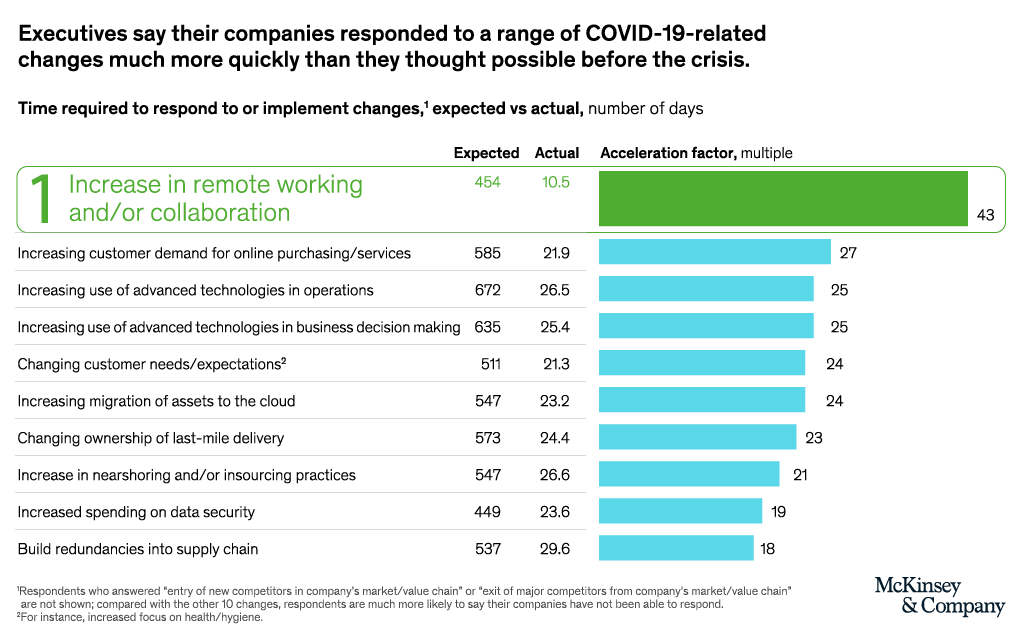Winning Climate Solutions Announced at Climate Call Grand Finale5 min read, 8 Nov 2024UAE Independent Climate Change Accelerators (UICCA) announced earlier this week the winners of the inaugural year of Climate Call, an...
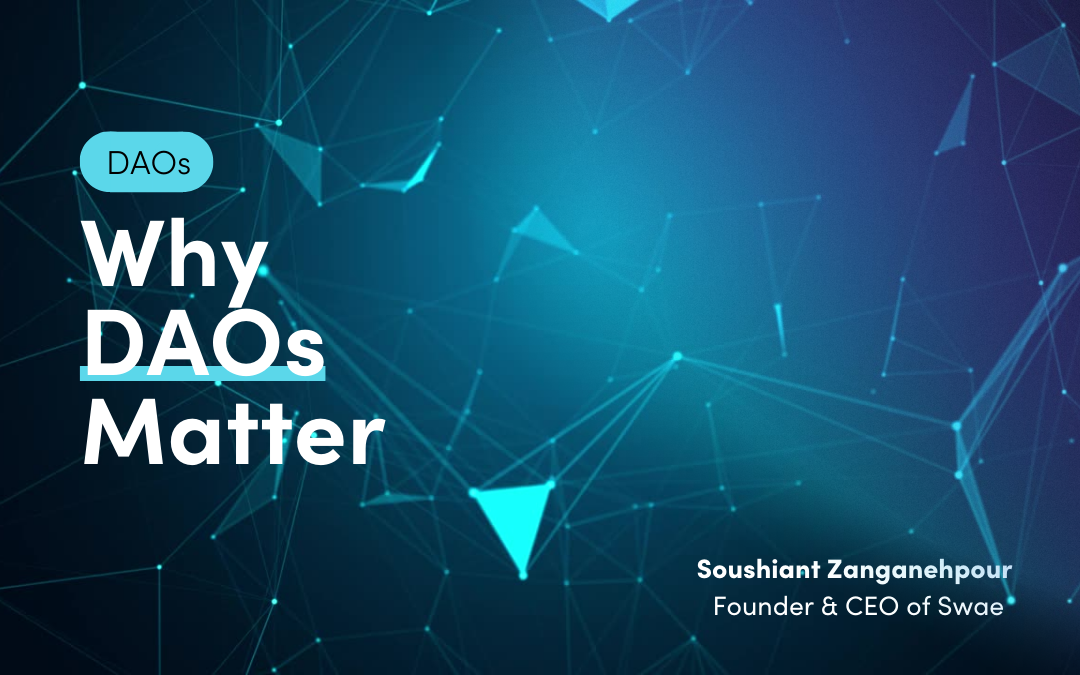
Why DAOs Matter
Why DAOs matter so much to Swae’s Mission
[And what is the future of DAO Governance?]
6 min read July 2022
The backstory to Swae’s pivot towards DAOs
by Soushiant Zanganehpour @Soushiant
Wait, what the heck is a DAO?
Imagine a group of people who collectively own a bank account and make group decisions about how to use the funds inside – That’s the simplest way to explain a DAO.
A decentralized autonomous organization (or “DAO” as they are called) is a new type of organization, similar in nature to a cooperative, where all the members have the right to participate in important decisions based on their ownership percentage (expressed in the amount of tokens they hold) in the DAO.
DAOs differ from a traditional enterprise because they don’t have a formal hierarchy or leadership layer. There is always a core team that creates a DAO but, when the DAO is up and running it is structurally, and legally designed to be flat, to allow all token holding members to create proposals, vote and debate ideas, and participate in decision-making.
Rather than being governed by a limited group, DAOs use a set of rules written down in code which are enforced by “smart contracts” and a network of computers running a shared software linked to a blockchain. This offers members a built-in model for the collective management of a DAOs code and assets.
To ensure fairness, voting power is distributed proportionally to the amount of tokens each member holds- there’s no central actor who can affect the DAO’s decisions, spending or outcomes. There is no single point of control, and no single point of failure- that’s true decentralization.
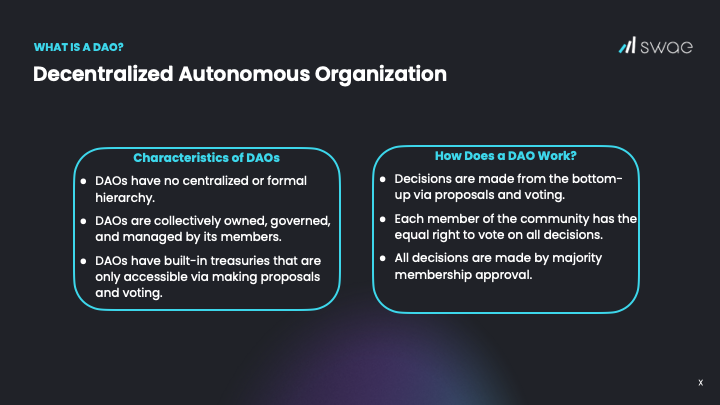
How important are DAOs? 📈
Simply put, DAOs are the future of new communities in the Web3/Crypto ecosystem.
Despite the issues in today’s financial markets, DAOs have been growing at an unprecedented rate, going from $0 in 2020 to $13B Market Cap in under 2 years.
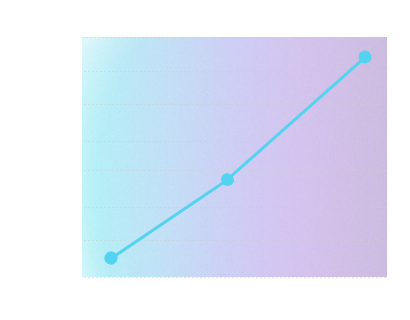
$13 Billion
Currently (July ‘22) there are…
4834
Active DAOs
56.6k
Decisions made
1.7 Million
Governance Tokens Held
662k
Decisions, decisions
Ok, but what do DAOs have to do with Swae? 🤝
DAOs are the ripest testing grounds for bottom-up decision making.
Swae was founded to give everyone inside an organization an equal voice in raising solutions and shaping decisions – an experience that is foreign inside most traditional organizations.
DAOs exist to make important decisions in a collective manner, automatically giving participatory powers to asset holding members of the DAO.
Nowhere do we see a greater opportunity for Swae’s ambitions and vision to be realized than within the world of Web3 with the explosive growth and mainstreaming of DAOs.
Inclusion, transparency and accountability are critical features to how a DAO functions and is governed.
These principles are built into the organization’s DNA and they closely resemble what Swae has digitized with its software to help organizations make collective decisions.
the challenge
The challenges of implementing bottom-up decision-making in corporate environments 🤌
Swae has proven that there is tremendous unrealized value to harness for any organization, simply from tapping into the collective intelligence from within.
Working with various types and sizes of client, we now know that creating an immersive and permissionless space for debate and bottom-up solutions allows any organization to stay on top of issues and air out tensions. This helps keep employees’ morale high, engagement booming, and the number of high quality creative solutions to existing problems flowing, ultimately impacting financial performance.
To highlight a couple of examples:
⦿ Lifelabs found over $200k in operational savings in less than 30 days all because the Swae methodology included people that were normally not part of a decision making process to contribute creative solutions to a very tricky operational problem.
⦿ The Swae process has also helped much larger organizations like the United Nations crowdsource over 750 strategy suggestions in less than 3 weeks to help them publish a fresh and diverse strategic plan for the next several decades of their existence – ideas that were cultivated from those that typically don’t have a voice at the decision making table.
These implementations have proven that a bottom-up system of sourcing decisions can be as good as the current top-down processes that dominate most organizations. At a minimum, it shows that the immersive and bottom-up process that Swae enables can live side-by-side with top down processes, complementing what is in place, ensuring those who are traditionally left out (due to language capabilities, time, or access to networks or clout) have a chance at participating and shaping decisions, so their unrevealed insights may ultimately benefit the organizations that employ or are responsible for them.
Despite all the positive outcomes from Swae, pilot after pilot also helped clarify how reluctant, apprehensive, and concerned most existing leaders are in traditional enterprises about creating too much inclusion in their workforce – worrying about the consequences of too many voices being aired on potentially sensitive topics without significantly controlling the conversations.
Swae is too big of a cultural leap forward for many corporations (for now).
Despite the resistance, DAOs have been openly embracing and loving what we have built with Swae. The also represent a much more culturally aligned type of organization that urgently needs Swae to support more efficient management of decision-making and governance issues.
the future of decision making
DAOs + Swae ❤️
DAOs currently face a lot of problems with collective decision making. The combination of Web2 and Web3 tools they use are not specifically designed to help coordinate decision-making within their communities. Currently in most DAOs, there isn’t a standard or streamlined way for DAOs to actively track ideas, conversations, proposals, and votes on a single platform.
Most DAOs use use a combination of communication and offline voting tools like a Discord, Telegram, Discourse, and Snapshot.
These lead to a lot of manual idea tracking and movement from one platform to another. DAO users get overwhelmed, spend too much time digging through threads to stay updated, and become disengaged, weakening DAOs who lose talent, ideas, and resources.




Swae provides DAOs with an all-in-one, collective decision-making and governance platform that helping DAOs simplify the collection and prioritization of decisions within their communities.
Swae’s platform and proposal development system can significantly improve the inefficiencies and poor user experience associated with raising, deliberating, and voting on proposals using standalone tools (like Discord, Telegram, Forums and the like), that were never intended to be end-to-end decision making and governance platforms.
Swae’s features help DAOs coordinate their members to raise polls, create and collaborate on proposals, collectively improve them through a structured debate, and vote on them all in one place. This helps DAOs avoid needing several platforms they currently use (like Discord, Discourse, Snapshot/Tally), and can thrive with just one tool (not 10).

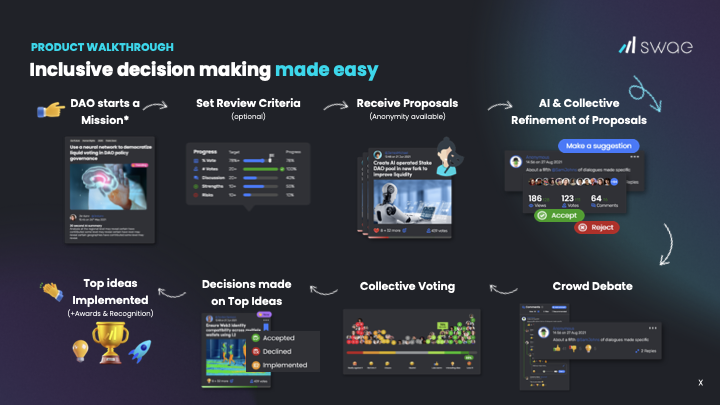

Decentralized decision making made easy

Swae is the all-in-one decision making and governance tool empowering the next generation of Web3 DAO communities

Customer success stories
DAOs using Swae ⚒️
While Swae started out as an idea management platform for large enterprises and smart cities, and since the product has been sector agnostic, DAOs have found the platform and feature set to be a real source of pain relief from using makeshift tools in managing, tracking and actionizing ideas in a collective environment.
So far we have been great results and currently have 3 DAOs already using Swae.
Most recently, we’ve been working with Decentralized Autonomous Organizations, to help them allocate investments and select grant projects through a community-driven and vetted voting and selection process. Swae helped DAO SingularityNet select 12 novel projects and allocate $1M worth of Grants towards them, and OpenExo to allocate over $3M worth of funding to 40 community-driven projects using Swae (learn more from Swae’s Case Studies).



Future scenario
Future Implications – What happens if DAOs succeed? 🌐
Whatever direction the world goes in and we head towards, we must all accept that our current systems for decision-making are less and less fitted for our communication and cultural era. We need new structures, processes and improved participation methods in order to create new solutions that prioritize and give political weight to ideas that advance community needs, over the narrow interests of the privileged few at the top.
If DAOs are successful in coordinating decisions and actions amongst disparate groups of people efficiently, they can have a very disruptive impact on traditional organizations and legal models.
Whatever the future holds, DAOs present the right opportunity to prove that a bottom-up decision making process is not only possible but useful and valuable, and we’re absolutely thrilled to support these experiments using Swae.
Venturing deeper into the DAO space will be our next big technological evolution of the product.
We’re so excited. 🚀
Watch this space!

More to explore…
Winning Climate Solutions Announced at Climate Call Grand Finale
COP28 Crowdsourcing Platform for Climate Innovation – Swae and UICCA launch ClimateCall.com
COP28 Crowdsourcing Platform for Climate Innovation Swae and UICCA launch ClimateCall.com4 min read, 23 Nov 2024The world today is facing three planetary crises: climate change, biodiversity loss and unmanageable amounts of...
Swae accellerates Web3 & DAO push with CDL
Swae accelerates into web3 with CDL One of the most respected accelerator programs in the world of technology entrepreneurship29 Nov 2022 1 min ReadWe are excited to announce that earlier this month, Swae was accepted into the Creative Destruction Lab (CDL) in its...



![Does your company’s culture empower people to speak up? [Brief Survey]](https://swae.io/wp-content/uploads/Swae_for-employee-engagement.png)
![Business Conflicts. Two Female Employees Arguing During Corporate Meeting In Office Swae_Harvard_Business_review_How to Be Seen as a Brilliant and Bold Leader [Become a Great Communicator].png](https://swae.io/wp-content/uploads/Swae_Employee_Engagement_Survey.jpg)

![High Performers in Companies Around the Globe Use Swae [Here Are 3 Reasons Why]](https://swae.io/wp-content/uploads/High-Performers-in-Companies-Around-the-Globe-Use-Swae-Here-Are-3-Reasons-Why-1080x675.png)
![Young businessman working on his laptop in spacious bright office. Swae_Harvard_Business_review_How to Be Seen as a Brilliant and Bold Leader [Become a Great Communicator].png](https://swae.io/wp-content/uploads/swae-high-performers-use-swae.jpg)
![Swae-team Swae_Harvard_Business_review_How to Be Seen as a Brilliant and Bold Leader [Become a Great Communicator].png](https://swae.io/wp-content/uploads/Swae-team.png)
![Swae_Harvard_Business_review_How to Be Seen as a Brilliant and Bold Leader [Become a Great Communicator].png Swae_Harvard_Business_review_How to Be Seen as a Brilliant and Bold Leader [Become a Great Communicator].png](https://swae.io/wp-content/uploads/african-american-businessman-boss-with-group-of-bu-2021-09-01-21-09-40-utc.png)
![Kaspersky_Bottom-up Innovation in Enterprise_Swae Swae_Harvard_Business_review_How to Be Seen as a Brilliant and Bold Leader [Become a Great Communicator].png](https://swae.io/wp-content/uploads/Kaspersky_Bottom-up-Innovation-in-Enterprise_Swae.png)


![Swae_Resources_MIT_Sloan_Review_Diversity, Equity and Inclusion Initiatives Need Action, Not Lip Service_plain Swae_Harvard_Business_review_How to Be Seen as a Brilliant and Bold Leader [Become a Great Communicator].png](https://swae.io/wp-content/uploads/Swae_Resources_MIT_Sloan_Review_Diversity-Equity-and-Inclusion-Initiatives-Need-Action-Not-Lip-Service_plain.png)
![Man speaking in a seminar Swae_Harvard_Business_review_How to Be Seen as a Brilliant and Bold Leader [Become a Great Communicator].png](https://swae.io/wp-content/uploads/swae-speak-up-culture-employee-engagement-companies-win-1024x765.jpg)


![Why Should I Care About the “Future of Work” [And What Does That Even Mean]](https://swae.io/wp-content/uploads/Future_of_Work_Swae-1080x675.png)




